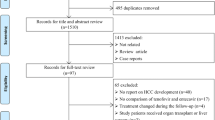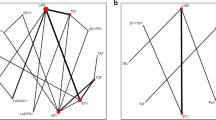Abstract
Entecavir (ETV) and tenofovir disoproxil fumarate (TDF) are equally recommended as first-line treatments for antiviral treatment-naïve (ART-naïve) chronic hepatitis B (CHB) patients by practice guidelines because of their similarly high antiviral efficacy and low resistance rate. However, whether one is superior to the other in terms of hepatocellular carcinoma (HCC) prevention is currently largely controversial. We aimed to identify and synthesize these existing studies regarding the HCC risk of these two highly potent antivirals in treatment-naïve CHB patients. PubMed, EMBASE, and Cochrane Library were searched for studies between January 1, 2012 and June 25, 2022. These studies used ETV monotherapy and/or TDF monotherapy to treat ART-naïve CHB patients and reported the incidence of HCC. The extracted data were analyzed using a DerSimonian–Laird random-effects models. The HCC incidence difference was expressed as hazard ratio (HR) and 95% confidence interval (95% CI). A total of 17 studies with 90,897 ART-naïve CHB patients (ETV = 60,980 vs TDF = 29,917) were included in this meta-analysis. Compared with ETV, TDF was associated with a significant lower cumulative incidence of HCC (HR 0.66; 95% CI 0.56–0.76). No significant heterogeneity or publication bias was found among the included studies (I2 = 48.1%, Begg’s p = 0.363 and Egger’s p = 0.748). TDF is associated with a lower risk of HCC compared with entecavir in ART-naïve CHB patients. The results suggest that TDF may be a better option for ART-naïve CHB patients with high HCC risks.




Similar content being viewed by others
References
World Health Organization. Hepatitis B. 2022. https://www.who.int/news-room/fact-sheets/detail/hepatitis-b. Accessed 24 Jun 2022.
Wang MD, Li C, Liang L, et al. Early and late recurrence of hepatitis B virus-associated hepatocellular carcinoma. Oncologist. 2020;25:e1541–51.
Chen CJ, Yang HI, Su J, et al. Risk of hepatocellular carcinoma across a biological gradient of serum hepatitis B virus DNA level. JAMA. 2006;295:65–73.
Wu CY, Chen YJ, Ho HJ, et al. Association between nucleoside analogues and risk of hepatitis B virus-related hepatocellular carcinoma recurrence following liver resection. JAMA. 2012;308:1906–14.
European Association for the Study of the Liver. EASL 2017 Clinical Practice Guidelines on the management of hepatitis B virus infection. J Hepatol. 2017;67:370–98.
Terrault NA, Lok ASF, McMahon BJ, et al. Update on prevention, diagnosis, and treatment of chronic hepatitis B: AASLD 2018 hepatitis B guidance. Hepatology. 2018;67:1560–99.
Idilman R, Gunsar F, Koruk M, et al. Long-term entecavir or tenofovir disoproxil fumarate therapy in treatment-naïve chronic hepatitis B patients in the real-world setting. J Viral Hepat. 2015;22:504–10.
Wu IT, Hu TH, Hung CH, et al. Comparison of the efficacy and safety of entecavir and tenofovir in nucleos(t)ide analogue-naive chronic hepatitis B patients with high viraemia: a retrospective cohort study. Clin Microbiol Infect. 2017;23:464–9.
Papatheodoridis GV, Chan HL, Hansen BE, Janssen HL, Lampertico P. Risk of hepatocellular carcinoma in chronic hepatitis B: assessment and modification with current antiviral therapy. J Hepatol. 2015;62:956–67.
Choi J, Kim HJ, Lee J, Cho S, Ko MJ, Lim YS. Risk of hepatocellular carcinoma in patients treated with entecavir vs tenofovir for chronic hepatitis B: a Korean nationwide cohort study. JAMA Oncol. 2019;5:30–6.
Ha Y, Chon YE, Kim MN, Lee JH, Hwang SG. Hepatocellular carcinoma and death and transplantation in chronic hepatitis B treated with entecavir or tenofovir disoproxil fumarate. Sci Rep. 2020;10:13537.
Yip TC, Wong VW, Chan HL, Tse YK, Lui GC, Wong GL. Tenofovir is associated with lower risk of hepatocellular carcinoma than entecavir in patients with chronic HBV infection in China. Gastroenterology. 2020;158(215–25): e6.
Kim WR, Telep LE, Jump B, et al. Risk of hepatocellular carcinoma in treatment-naïve chronic hepatitis B patients receiving tenofovir disoproxil fumarate versus entecavir in the United States. Aliment Pharmacol Ther. 2022;55:828–35.
Shin JW, Jeong J, Jung SW, et al. Comparable incidence of hepatocellular carcinoma in chronic hepatitis B patients treated with entecavir or tenofovir. Dig Dis Sci. 2021;66:1739–50.
Oh H, Lee HY, Kim J, Kim YJ. Systematic review with meta-analysis: comparison of the risk of hepatocellular carcinoma in antiviral-naive chronic hepatitis B patients treated with entecavir versus tenofovir: the devil in the detail. Cancers (Basel). 2022;14:2617.
Huang ZH, Lu GY, Qiu LX, et al. Risk of hepatocellular carcinoma in antiviral treatment-naive chronic hepatitis B patients treated with entecavir or tenofovir disoproxil fumarate: a network meta-analysis. BMC Cancer. 2022;22:287.
Li M, Lv T, Wu S, et al. Tenofovir versus entecavir in lowering the risk of hepatocellular carcinoma development in patients with chronic hepatitis B: a critical systematic review and meta-analysis. Hepatol Int. 2020;14:105–14.
Choi WM, Choi J, Lim YS. Effects of tenofovir vs entecavir on risk of hepatocellular carcinoma in patients with chronic HBV infection: a systematic review and meta-analysis. Clin Gastroenterol Hepatol. 2021;19:246–58e9.
Liu H, Shi Y, Hayden JC, Ryan PM, Rahmani J, Yu G. Tenofovir treatment has lower risk of hepatocellular carcinoma than entecavir treatment in patients with chronic hepatitis B: a systematic review and meta-analysis. Liver Cancer. 2020;9:468–76.
Choi WM, Yip TC, Lim YS, Wong GL, Kim WR. Methodological challenges of performing meta-analyses to compare the risk of hepatocellular carcinoma between chronic hepatitis B treatments. J Hepatol. 2022;76:186–94.
Higgins JP, Altman DG, Gotzsche PC, et al. The Cochrane Collaboration’s tool for assessing risk of bias in randomised trials. BMJ. 2011;343: d5928.
Stang A. Critical evaluation of the Newcastle-Ottawa scale for the assessment of the quality of nonrandomized studies in meta-analyses. Eur J Epidemiol. 2010;25:603–5.
Higgins JP, Thompson SG, Deeks JJ, Altman DG. Measuring inconsistency in meta-analyses. BMJ. 2003;327:557–60.
Na JE, Sinn DH, Lee JH, et al. Efficacy of entecavir versus tenofovir in preventing hepatocellular carcinoma in patients with chronic hepatitis B with maintained virologic response. J Viral Hepat. 2021;28:1392–9.
Huang Y, Gui H, Chen L, et al. Clinical outcomes in tenofovir versus entecavir treatment for treatment-naive chronic hepatitis b with compensatory cirrhosis in China—an interim analysis. Hepatology. 2021;74:473A.
Teng W, Chang TT, Yang HI, et al. Risk scores to predict HCC and the benefits of antiviral therapy for CHB patients in gray zone of treatment guidelines. Hepatol Int. 2021;15:1421–30.
Guzelbulut F, Gokcen P, Can G, et al. Comparison of the efficacy of entecavir and tenofovir in reducing hepatocellular carcinoma risk in chronic hepatitis b patients: a real-life study in turkey. Turk J Gastroenterol. 2021;32:412–21.
Kim SU, Seo YS, Lee HA, et al. A multicenter study of entecavir vs. tenofovir on prognosis of treatment-naïve chronic hepatitis B in South Korea. J Hepatol. 2019;71:456–64.
Lee SW, Kwon JH, Lee HL, et al. Comparison of tenofovir and entecavir on the risk of hepatocellular carcinoma and mortality in treatment-naïve patients with chronic hepatitis B in Korea: a large-scale, propensity score analysis. Gut. 2020;69:1301–8.
Jang JW, Choi JY, Kim YS, et al. Long-term effect of antiviral therapy on disease course after decompensation in patients with hepatitis B virus-related cirrhosis. Hepatology. 2015;61:1809–20.
Ha I, Chung JW, Jang ES, Jeong SH, Kim JW. Comparison of the on-treatment risks for hepatocellular carcinoma between entecavir and tenofovir: a propensity score matching analysis. J Gastroenterol Hepatol. 2020;35:1774–81.
Park ES, Lee AR, Kim DH, et al. Identification of a quadruple mutation that confers tenofovir resistance in chronic hepatitis B patients. J Hepatol. 2019;70:1093–102.
Shin JW, Jung SW, Lee SB, et al. Medication nonadherence increases hepatocellular carcinoma, cirrhotic complications, and mortality in chronic hepatitis B patients treated with entecavir. Am J Gastroenterol. 2018;113:998–1008.
Marcellin P, Gane E, Buti M, et al. Regression of cirrhosis during treatment with tenofovir disoproxil fumarate for chronic hepatitis B: a 5-year open-label follow-up study. Lancet. 2013;381:468–75.
Chang TT, Liaw YF, Wu SS, et al. Long-term entecavir therapy results in the reversal of fibrosis/cirrhosis and continued histological improvement in patients with chronic hepatitis B. Hepatology. 2010;52:886–93.
Papatheodoridis GV, Dalekos GN, Idilman R, et al. Similar risk of hepatocellular carcinoma during long-term entecavir or tenofovir therapy in Caucasian patients with chronic hepatitis B. J Hepatol. 2020;73:1037–45.
Papatheodoridis GV, Idilman R, Dalekos GN, et al. The risk of hepatocellular carcinoma decreases after the first 5 years of entecavir or tenofovir in Caucasians with chronic hepatitis B. Hepatology. 2017;66:1444–53.
Lee SW, Choi J, Kim SU, Lim YS. Entecavir versus tenofovir in patients with chronic hepatitis B: enemies or partners in the prevention of hepatocellular carcinoma. Clin Mol Hepatol. 2021;27:402–12.
Liu S, Deng R, Zhou B, et al. Association of serum hepatitis B virus RNA with hepatocellular carcinoma risk in chronic hepatitis B patients under nucleos(t)ide analogues therapy. J Infect Dis. 2022;226:881–90.
Mak LY, Huang Q, Wong DK, et al. Residual HBV DNA and pgRNA viraemia is associated with hepatocellular carcinoma in chronic hepatitis B patients on antiviral therapy. J Gastroenterol. 2021;56:479–88.
Funding
This work was supported by Beijing Hospitals Authority focal medical development plan (ZYLX202138).
Author information
Authors and Affiliations
Contributions
CL and JS provided idea. JS, YW and LH performed data extraction and searches. LZ and JS analyzed the data. CL and JS wrote the paper.
Corresponding author
Ethics declarations
Competing interests
The authors have no conflicts of interest to declare.
Ethical approval
Since our study synthesized previously published literature, informed consent and ethics-board approval were not required.
Additional information
Publisher's Note
Springer Nature remains neutral with regard to jurisdictional claims in published maps and institutional affiliations.
Supplementary Information
Below is the link to the electronic supplementary material.
Rights and permissions
Springer Nature or its licensor (e.g. a society or other partner) holds exclusive rights to this article under a publishing agreement with the author(s) or other rightsholder(s); author self-archiving of the accepted manuscript version of this article is solely governed by the terms of such publishing agreement and applicable law.
About this article
Cite this article
Shao, J., Wang, Y., Hu, L. et al. Lower risk of hepatocellular carcinoma with tenofovir than entecavir in antiviral treatment-naïve chronic hepatitis B patients: a systematic review and meta-analysis involving 90,897 participants. Clin Exp Med 23, 2131–2140 (2023). https://doi.org/10.1007/s10238-023-00990-w
Received:
Accepted:
Published:
Issue Date:
DOI: https://doi.org/10.1007/s10238-023-00990-w




